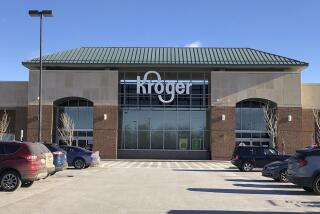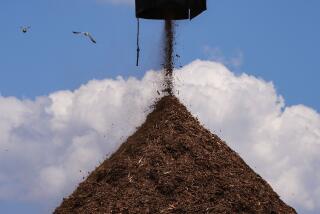A powerful use for spoiled food
- Share via
What happens to the 40% of food produced but never eaten in the U.S. each year, the mounds of perfect fruit passed over by grocery store shoppers, the tons of meat and milk left to expire?
At Ralphs, one of the oldest and largest supermarket chains on the West Coast, it helps keep the power on.
In a sprawling Compton distribution center that the company shares with its fellow Kroger Co. subsidiary Food 4 Less, organic matter otherwise destined for a landfill is rerouted instead into the facility’s energy grid. Though many grocery stores have tried to cut down on food waste and experiment with alternative energy, Kroger says it’s the first supermarket company in the country to do both simultaneously.
The technology that helps transform moldy chicken and stale bread into clean electricity is known as an anaerobic digester system. At the 59-acre Compton site, which serves 359 Southern California stores, more than 100 onlookers gathered Wednesday to watch the system go to work.
Several chest-high trash bins containing a feast of limp waffles, wilting flowers, bruised mangoes and plastic-wrapped steak sat in an airy space laced with piping. Stores send food unable to be donated or sold to the facility, where it is dumped into a massive grinder — cardboard and plastic packaging included.
After being pulverized, the mass is sent to a pulping machine, which filters out inorganic materials such as glass and metal and mixes in hot wastewater from a nearby dairy creamery to create a sludgy substance.
Mike Vriens, Ralphs vice president of industrial engineering, describes the goop as a “juicy milkshake” of trash.
From there, the mulch is piped into a 250,000-gallon staging tank before being steadily fed into a 2-million-gallon silo. The contraption essentially functions as a multi-story stomach.
Inside, devoid of oxygen, bacteria munch away on the liquid refuse, naturally converting it into methane gas. The gas, which floats to the top of the tank, is siphoned out to power three on-site turbine engines.
The 13 million kilowatt-hours of electricity they produce per year could power more than 2,000 California homes over the period, according to Kroger.
Excess water from the digester is pumped out, purified and sent into the industrial sewer. Leftover sludge becomes nutrient-rich organic fertilizer, enough to nourish 8,000 acres of soil.
The so-called closed-loop system was developed by Boston start-up Feed Resource Recovery and offsets more than 20% of the distribution center’s energy demands — all without producing any pungent odors.
The program helps Kroger reduce its waste by 150 tons a day. The trash otherwise would have been sent to Bakersfield to be composted, hauled away six times a day by diesel trucks traveling 500,000 miles a year.
Kroger won’t say exactly how much it spent on the anaerobic digester but estimates that it will offer an 18.5% return on the company’s investment. The project, over its lifetime, could help the grocer save $110 million. The supermarket giant is considering similar technologies for its La Habra and Riverside facilities and other Kroger locations nationwide.
The grocery chain’s move, some four years in the making, comes amid heated debate over the nation’s food and energy supply.
In August, the Natural Resources Defense Council reported that 40% of food in the U.S. goes uneaten — the equivalent of 20 pounds of food per person per month. The waste is shuttled to landfills, where it contributes to 25% of the country’s methane emissions.
Some grocers have tried to cut back on garbage by putting less food out on display and even composting leftover products. Northern California chain Andronico’s Community Market sells aesthetically marred but still edible produce at a discount. The Austin, Tex., store In.gredients says it sends less than a pound of waste to landfills each month by offering reusable and compostable containers in-house.
Other chains try to reduce their environmental footprint through clean-electricity projects. Whole Foods Market said solar energy helps power stores in Berkeley, Brentwood and elsewhere. Wal-Mart is testing wind turbines, installing solar panels and fuel cells and says three-quarters of its California facilities use some form of green energy.
But in recent years, amid high waste disposal costs and uncertain energy prices, anaerobic digesters have gained favor. The technology has been proposed as a fuel source for data centers, farms, government buildings and other sites.
Nick Whitman, president of Feed Resource Recovery, said Kroger’s new anaerobic digester in Compton may help encourage future installations in more urban areas.
“We’ve had to solve some really critical problems — sanitation, efficiency and reliability issues — that have plagued anaerobic digestion and prevented its wider adoption in the U.S.,” he said Wednesday.
“We’ve been able to bring digestion out of the farms and off the composters and into cities and industrial centers.”
More to Read
Inside the business of entertainment
The Wide Shot brings you news, analysis and insights on everything from streaming wars to production — and what it all means for the future.
You may occasionally receive promotional content from the Los Angeles Times.







